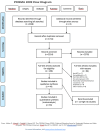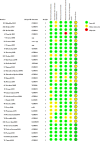Systematic review on biomechanical effects of high-velocity, low amplitude spinal manipulation
- PMID: 40680063
- PMCID: PMC12273944
- DOI: 10.1371/journal.pone.0328048
Systematic review on biomechanical effects of high-velocity, low amplitude spinal manipulation
Abstract
Background: Spinal manipulative therapy uses high-velocity low-amplitude (HVLA) thrusts which are clinically effective, but underlying mechanisms are still unknown.
Objective: To summarize the evidence for biomechanical effects of HVLA thrusts in asymptomatic and symptomatic humans as well as for a possible link between biomechanical effects and clinical effectiveness.
Study design: Systematic review of randomized controlled trials.
Methods: An information specialist conducted systematic literature searches in six databases [Medline (OvidSP), Premedline (PubMed), CINAHL, EMBASE, Cochrane, and Biosis]. Studies were selected by two authors and classified using the revised Cochrane risk-of-bias tool for randomized trials (RoB 2). Results were qualitatively summarized per biomechanical output [range of motion (ROM) according to the spinal region where HVLA thrusts were applied, facet joint gapping, and spinal stiffness].
Results: The thirty-three included studies were heterogeneous regarding participant characteristics, intervention frequency and outcomes. Twenty-seven studies reported on the effects of HVLA thrusts on spinal ROM. There is evidence increased cervical ROM following cervical HVLA thrusts on cervical ROM [9/15 studies with a positive treatment effect (5 low risk of bias/4 some concern) and increased cervical ROM following thoracic HVLA thrusts [8/8 studies (4 low risk of bias/4 some concern)]. The effects of a thoracic and lumbar HVLA thrusts on the respective ROM were less clear. Three (2 low risk/1 some concern) studies on facet joint gapping showed increased gapping following HVLA thrusts compared to side-posture positioning, and a single study (some concern) on spinal stiffness showed no effect of HVLA thrusts. Only one study (some concern) linked the biomechanical to clinical outcomes.
Conclusion: HVLA thrusts, either applied to the cervical or the thoracic spine, appear to increase cervical ROM, based on studies with low risk and studies with some concern regarding risk of bias. For all other outcomes, the included studies were too heterogeneous and too few to draw any sound conclusion. Future studies on the biomechanical effects of HVLA thrusts should link the biomechanical to clinical outcomes such as pain and disability.
Prospero registration: CRD42018096963.
Copyright: © 2025 Langenfeld et al. This is an open access article distributed under the terms of the Creative Commons Attribution License, which permits unrestricted use, distribution, and reproduction in any medium, provided the original author and source are credited.
Conflict of interest statement
The authors have declared that no competing interest exist.
Figures
References
-
- Wong JJ, Côté P, Sutton DA, Randhawa K, Yu H, Varatharajan S, et al. Clinical practice guidelines for the noninvasive management of low back pain: a systematic review by the Ontario Protocol for Traffic Injury Management (OPTIMa) Collaboration. Eur J Pain. 2017;21(2):201–16. doi: 10.1002/ejp.931 - DOI - PubMed
Publication types
MeSH terms
LinkOut - more resources
Full Text Sources



